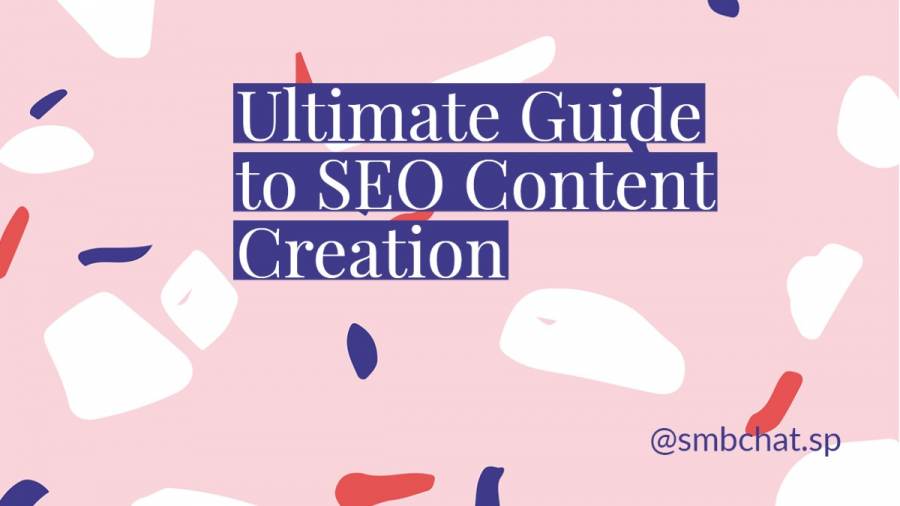The Ultimate Guide to Creating Content Clusters
Why do your competitors seem to be getting ahead and not you?
You've done all you could to improve your organic rankings and increase traffic, but nothing seems to work.
So you decide to try it one more last time.
Just you, your computer, and the voice in your head.. (and we both know how "supportive" that voice in your head can get.)
You sit down on a blank spreadsheet and write the words "content cluster" at the top.
And after a few minutes, you think to yourself, "What the heck am I meant to do next?"
It's frustrating when all the inspiration and energy gets used to talking yourself down and questioning your capabilities. "Should I really be doing this?"
So how can you do things differently in this maze of SEO where there are more paths than clues?
Relax. There's a more excellent way.
Enter content clusters.
Think for a moment.
At the core of your content strategy lies a list of objectives:
- To build industry authority.
- Meet your buyer at every stage.
- Lead generation and increased conversions
- And get higher SERP rankings.
However, approaching these goals individually will only lead to a series of frustrations, wasted budget, and a haphazard arrangement of content that never ranks.
What if there's a way you could hit all the four birds with one stone… forever?
Just, what if?
That's why I'm so glad you found your way here.
Join me for the next 8 mins and 20 seconds as I take you through this time-tested strategy that works wonders. And if you're wondering (yes, I did the maths.)
Relevant Reading:
10 Best Content Writing Services for 2022
Flesch Reading Scale: Everything You Need to Know
Stripping the SEO Scycrapper Technique Down to Its Barebones
What are Content Clusters?
Picture a cobweb.
In the middle lies the spider and then a lacework of strands that stretches out between fine branches.
The result? An artwork of nature able to conjure awe in all who welcome its magic.
Content clusters work in a similar fashion.
Topic clusters are a collective group of related content that widely covers a broad subject area.
So you have one major topic that you'd want to cover in-depth, but rather than writing one hefty blog post and optimizing the hell out of it, you create a pillar post and then other supporting blogs that elaborate on an idea represented in the pillar post whilst linking the blogs back to the pillar page.
So the three main components are:
- One broadly focused pillar page.
- Multiple in-depth blogs that support the main pillar page.
- Strategically placed internal links that connect the topics and pillar page.
I'll explain the three in a minute.
The Pillar Post
A pillar page is essentially the cornerstone that gives credence to all the other topics of the cluster. It is generally longer, broader in scope, and touches all the other facets of the set.
Here's our blog on the fine art of creating pillar posts.
Think of it as a mother chicken shielding her chicks.
The best way to choose a pillar post is by seeking a relatively "high-performing post" that covers a broad area and revamping it. Besides, you can also carry out a volume search analysis to get quality ideas that can be great candidates for pillar pages.
For instance, if you're in the automotive niche, you could target the term "Most reliable cars."
The search results show that the phrase has a search volume of about 60,500 each month. However, trying to write that blog and satisfactorily cover the subject comprehensively would take you around 10k words.
But trust me, no one wants to read a novel in the disguise of a blog.
So instead, you craft one post that broadly covers all ideas at a surface level and then leaves the juicy content to the…
Cluster Content
These are in-depth posts covering an idea brought about in the pillar post but wasn't explained.
Since we had the pillar post as the mother chicken, now take the cluster topics as the chicks.
Remember, they must have a close semblance to their mother but still unique in their own right.
They talk more about less, while pillar posts talk less about more.
Makes sense?
Here's an example from the pillar page we created to ease your trouble.
- 10 things to Consider Before Buying Your New Car
- When is the Best Time to Buy a Car?
- Should I buy a New Car or a Used Car?
- Buying vs. leasing a car: Which is the best option?
- Best Dealerships to Buy a Car
There's no general rule of thumb as to how many cluster pieces you need to create, but somewhere above 5 sounds good.
Internal Links
Now your chicks can't be scattered everywhere without their mother, right?
The mother's wings and feathers embrace and shield them to keep the chicks all warm and fuzzy.
Internal links are the fabric that holds your cluster together. Without them, your topic cluster would eventually succumb and die from the cold without.
So the individual cluster topics link back to the central pillar page, and the pillar page links back to all the cluster topics.
If done well, with the patience and determination of a spider, you can replicate something as intricate as a content web– again and again.
How Content Clusters Boost SEO and Why You Should Use Them
Approaching your content from this angle helps you visualize your content as one bespoke framework that hits all your marketing goals with a single strategy.
But don't take my word for it. Here's how.
1. Rank Well on Google by Helping Google Understand You
Just recently, Google changed its algorithm to favor topic-based content.
In times past, all you needed was one looooong blog post, optimize it, and it would effortlessly rank for several keywords on Google.
Try that now and…
Google now understands the relevancy of specific pages on your website and will only provide the best results possible to a searcher. Like location, intent, and personalization, it goes beyond just keywords to things that matter to the searcher.
Lastly, Google made a significant breakthrough in October 2020, where the algorithm understands how people typically explore a certain topic through understanding subtopics around a broad interest through neural nets.
In simpler terms, Google is after determining a searcher's true intent rather than providing low-quality, keyword-stuffed content that doesn't help its readers.
And whenever Google talks, do yourself the favor of silently listening and swiftly taking action. Or else, this ruthless engine will ensure you painfully pay the price by sitting on page 361 as if nothing happened.
This means if you want to find favor with Google and please the algorithm, you have to gear your strategy towards helping Google achieve its goals.
Content clusters help you achieve this by linking related content and arranging it systematically in a way that seeks to benefit your readers and search engine's users.
2. Enhance Context, Relevance, and Authority
The truth is that many brands, yours included, have more than one area of expertise.
Thinking of how you can develop your content around these critical areas rather than one keyword at a time will help Google understand the hierarchy of your website and how content interrelates.
For instance, let's say you're in the automotive niche selling cars.
- You have expertise in different brands of automobiles.
- You understand different modes of financing new car owners.
- You know the challenges buyers go through when sourcing a new vehicle.
- You know how your clients can maintain their cars post-purchase.
Creating content around these areas makes Google understand that you're an expert in your field since your content focuses on automotive and provides valuable information to readers.
In one word: Context.
And since most of your content is linked back to a certain pillar page, Google knows that of all the pages, the one with the most internal links is the most important.
3. Meet Your Buyer at Each Stage
As we'd pointed out earlier, Google is on a mission to holistically understand the searcher's journey.
So why shouldn't you focus on working with Google rather than working against the algorithm?
This means visualizing your client's journey from the top of the funnel, the middle of the funnel, and down to the bottom of the funnel.
Instead of thinking about keywords only, you're looking at: What's this person asking if they're trying to buy an automobile?
- What information do they need to know about automotive?
- They're looking at reviews. What's the best automotive dealer?
- Comparing costs. Which is the cheapest car dealer near me?
- Post-purchase experience. How do I maintain my vehicle?
You need content for all these stages.
That's the whole point of content clusters. It puts you at every stage of the buyer's frustrations and subconsciously convinces them you're the authority.
4. Rank for Multiple Keywords with a Single Strategy
There's no denying that there are way too many suggestions on how to rank for your desired keywords.
The end finds it on wasted years of shadowboxing through SEO and jumping from one strategy to another without necessarily achieving any worthwhile results.
Creating content clusters helps you rank for many relevant keywords under one single strategy that leaves you, your clients, and Google happy.
5. Have a Well Arranged Website for Hierarchy
What's more fascinating than a systematically arranged site?
Okay, I know there's an answer to that, but if you're a marketer, then the beauty of content clusters is somewhere at the top.
How to Build Content Clusters
Now that you have a clear understanding of why we recommend this strategy let's get into the intricacies of creating one.
1. Know Your Audience
Imagine creating a sizzling dinner for mystery guests.
You set the table.
Pom pom cottage pie, beef bourguignon, rare roast beef slices as thin as paper, steak in a green sauce, cheese that melts on your tongue served with sweet blue grapes.
Then comes the guests and…
They're all vegetarians.
Well done, Chef. It doesn't matter if you have a degree from Le Cordon Bleu, but as far as this dinner was concerned, you failed.
Creating content clusters without understanding whom you're creating for is just a recipe for disaster.
You need to understand your audience, map their journey, address their frustrations, and still do a little more. With this in mind, start addressing creating content at each stage that deals with what keeps them up at night.
2. Understand Your Goals
If you don't know where you want to go, you'll eventually arrive where you don't want to go.
Goal setting is the purposeful and explicit layout of what you want when you want it and a clear path to achieve that goal. Instead of just running aimlessly, a clear goal would be to prepare and start training to complete the next thanks-giving half marathon.
Do you want organic traffic?
Do you want your strategy to suck in leads like a vacuum on steroids?
Then if so, how will you measure the success of this strategy?
Have a clear goal of what you want the content cluster to achieve. This will help you create the strategy, analyze, and refine your cluster.
3. Perform Keyword Research
I get it.
You've heard this name more times than you can count the episodes on Friends.
And well, it's becoming a bit numbing.
Spoiler alert. It isn't as tricky as SEOs make it seem.
It's only as difficult as you make it. In fact, in my opinion, understanding the prerequisite first two steps is the most difficult of all the other steps.
If you know your goal and your audience, then the keyword tools will make it easier.
Keyword research means searching for the words that your audience uses to find you.
It's as simple as that.
There are many tools that can help you with keyword research, including:
- Keywords Everywhere
- Spyfu
- SEMRush
- Ahrefs
And any other SEO tool you find.
Here at Zoey, we use Spyfu and Keywords everywhere, and they work exceptionally well as other SEO tools.
Put yourself in your reader's shoes and try thinking of the questions they might be asking. Then walk that road as their journey proceeds from one stage to another while making sure you're aware of the next action they will take. Then make sure there's content to meet them at the next stage, and then the next, until they make a purchase.
Then create also more content that tries to retain them as loyal clients.
Keyword research will help you discover relatively new phrases you can target and help you group clusters accordingly. But, please, don't focus solely only on the search volume, but focus more on the intent.
TL;DR? Here's an ultimate guide on how to go about keyword research.
4. Ideate and Create the Pillar Pages
Now, after you've known your areas of strength and how you can use these strengths to turn your potential customer into a loyal client, down to the intricacies of creation.
However, I don't recommend starting with writing the pillar page first; start with the clusters.
You only ideate the pillar post first.
I know it's a bit counterintuitive, especially considering that the chicks can't be there before the mother chicken.
But here's the logic behind it: Starting with cluster content will ensure that you don't cover too much on the pillar content since you'll already have that in the clusters.
So the pillar post will only have juicy content that tantalizes your readers and then enticing links and CTAs that lead your readers to the cluster content to know more.
If you're stuck on how to go about that, check out this ultimate guide on creating no-fluff content.
5. Flesh Out the Topic clusters
Remember, these are the foundational pieces of the content and need to be more elaborate and in-depth than the pillar post.
Hence, you should focus on writing them well and providing information at a very high level.
Here are some essential blogs that can help you learn more about learning to write well.
6. Strategically Place Your Internal Links
Remember how vague drawings looked before we joined the dots in Kindergarten? But immediately, we were done joining them; an image would come into life that we wouldn't have thought was anywhere buried in those disjointed joints.
So it is with internal links.
Internal linking makes your strategy complete and is the fuel on which your clusters thrive. Internal links provide search engines with more context while also passing value to other topics in the same cluster.
Think of them as the glue, without which your strategy would be crumbling hands down.
One mistake that most people often make at this stage is placing the internal links "non strategically." If you have many anchor texts where you can add the internal link, try putting it on the area that mostly focuses on the specific topic.
Mistakes to Avoid When Creating Content Clusters
There are two main mistakes that I see people make when creating content clusters.
One, they avoid linking content clusters to other clusters to avoid interrelating two different clusters. However, nothing thrives in isolation, and our content, in one way or another, is all related unless you're running a Tech firm and grocery store on the same website.
So don't fear linking clusters to clusters since this helps Google get an idea of how your content as a whole is related.
Two, a good number of people tend to flood their clusters with the same topics that target the same keyword. In the long run, this ends up having many blogs from your website competing in terms of ranking; a term SEOs call keyword cannibalization.
So avoid creating blogs like:
- How to buy a car in 2021
- 10 Ways to buy the best car
- Tips for buying the best car
While at face value, this might look like a strategy that's working, at the core of it, it's flawed since it's targeting the same keyword. "How to buy a car."
To maneuver this, quickly type any two phrases that you think are related on Google and check whether they have the same SERP results. If they do, change one topic and focus on finding phrases that target a different intent.
Content Clusters are Time-Consuming… But That's What We Do For a Living
So how can you work smarter, not harder, in content marketing and still get ahead of your competitors?
Well, that's it, buddy.
Far too many people get caught up in the idea of the latest tools, trends and looking up for that magic bullet in content marketing that doesn't exist.
Content marketing is a long-term game and what I've laid down in this blog is all you need to get started. But we know that taking your time to craft such a well-thought strategy can be overwhelming.
That's why we want to be an active contributor to the success of your business by helping you model this strategy, and there's no better place to start than our content writing services. Feel free to reach out to us, and we'll be more than willing to assist.
Photo by Green Chameleon on Unsplash. Thanks, Green :)

















